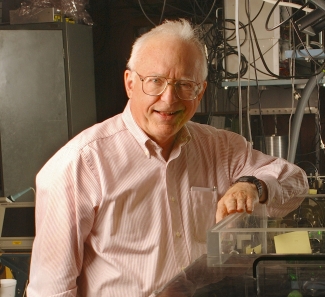JILA's Laser Guru Jan Hall spoke about Light, Atomic Clocks, and Testing Einstein’s Assumptions on Nov. 4, 2015, at the Keck Institute for Space Studies. A lively video of the talk can be found at http://kiss.caltech.edu/new_website/lectures/Hall_Lecture_2015.html
Jan's abstract is a good synopsis of the video talk: Even though this is the 55th year of the laser, progress in its control and application in precision measurements is still accelerating. The optical frequency comb technology exploded in 1999-2000 from the synthesis of advances in independent fields of laser stabilization, ultrafast lasers, and nonlinear optical fibers, enabling a thousand-fold advance in optical frequency measurement, and searches (in the 17th digit) for time-variation of physical "constants." Several optical frequency standards now have far better performance than the well-established Cs clock that defines time in the SI (metric system) measurement system. But adopting a new “atomic clock” to “tick out the seconds” will be daunting in many ways. Current advances in ultraprecise locking are also making possible stable optical frequencies defined by length and the speed of light, as well as by locking lasers to the resonant frequency of atoms. These two “clocks” represent our current prototypes of the clocks postulated by Einstein in 1905 in formulating the Theory of Special Relativity, which now should be testable into the 18th decimal in a proposed space-based experiment now being planned by our international Space-Time Asymmetry Research collaboration (STAR). An improvement in the modulation strategy may allow unexpectedly good frequency-standard performance in a compact device, and so be useful on earth as well.



 The Physics Frontiers Centers (PFC) program supports university-based centers and institutes where the collective efforts of a larger group of individuals can enable transformational advances in the most promising research areas. The program is designed to foster major breakthroughs at the intellectual frontiers of physics by providing needed resources such as combinations of talents, skills, disciplines, and/or specialized infrastructure, not usually available to individual investigators or small groups, in an environment in which the collective efforts of the larger group can be shown to be seminal to promoting significant progress in the science and the education of students. PFCs also include creative, substantive activities aimed at enhancing education, broadening participation of traditionally underrepresented groups, and outreach to the scientific community and general public.
The Physics Frontiers Centers (PFC) program supports university-based centers and institutes where the collective efforts of a larger group of individuals can enable transformational advances in the most promising research areas. The program is designed to foster major breakthroughs at the intellectual frontiers of physics by providing needed resources such as combinations of talents, skills, disciplines, and/or specialized infrastructure, not usually available to individual investigators or small groups, in an environment in which the collective efforts of the larger group can be shown to be seminal to promoting significant progress in the science and the education of students. PFCs also include creative, substantive activities aimed at enhancing education, broadening participation of traditionally underrepresented groups, and outreach to the scientific community and general public.